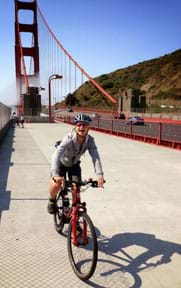
Summary
Through a series of three lessons, each with its own hands-on activity, students are introduced to 1) forces, loads and stress, 2) tensile loads and failure, and 3) torsion on structures—fundamental physics concepts that are critical to understanding the built world. The associated activities engage students through experimenting with hot glue gun sticks to experience tension, compression and torsion; the design of plastic chair webbing strips; and problem-solving to reinforce foam insulation "antenna towers" to withstand specified bending and twisting.Engineering Connection
Flexing, deforming, twisting—what happens to materials when forces are applied? Consideration of compression, tension, shear, bending and torsion figures into the design of all the physical objects and structures that engineers create—everything from skyscrapers and bicycles to keyboards, bridge cables, medical implants and snow shovels. To make the designs function as intended, and perform reliably and safely, engineers must apply a thorough understanding of forces and their effects. Engineers are involved in choosing suitable materials and designing new materials such as composites with specific characteristics capable of responding to forces in a desired way.
Educational Standards
Each TeachEngineering lesson or activity is correlated to one or more K-12 science,
technology, engineering or math (STEM) educational standards.
All 100,000+ K-12 STEM standards covered in TeachEngineering are collected, maintained and packaged by the Achievement Standards Network (ASN),
a project of D2L (www.achievementstandards.org).
In the ASN, standards are hierarchically structured: first by source; e.g., by state; within source by type; e.g., science or mathematics;
within type by subtype, then by grade, etc.
Each TeachEngineering lesson or activity is correlated to one or more K-12 science, technology, engineering or math (STEM) educational standards.
All 100,000+ K-12 STEM standards covered in TeachEngineering are collected, maintained and packaged by the Achievement Standards Network (ASN), a project of D2L (www.achievementstandards.org).
In the ASN, standards are hierarchically structured: first by source; e.g., by state; within source by type; e.g., science or mathematics; within type by subtype, then by grade, etc.
See individual lessons and activities for standards alignment.
Subscribe
Get the inside scoop on all things TeachEngineering such as new site features, curriculum updates, video releases, and more by signing up for our newsletter!Unit Schedule
Suggested order to conduct the lessons and hands-on activities:
- Lesson 1: Fairly Fundamental Facts about Forces and Structures
- Lesson 1's activity: Forces in Structures: Glue Sticks Bend & Twist
- Lesson 2: Exploring the Forces of Tension
- Lesson 2's activity: Stop the Stretching
- Lesson 3: Investigating Torque
- Lesson 3's activity: Wimpy Radar Antenna: Reinforced Tower Test, Analyze & Improve
More Curriculum Like This

Students learn about torsion as a force acting upon structures and have the opportunity to design something to withstand this force.

Students are introduced to the five fundamental loads: compression, tension, shear, bending and torsion. They learn about the different kinds of stress each force exerts on objects.
Copyright
© 2016 by Regents of the University of Colorado; original © 2005 Worcester Polytechnic InstituteContributors
See individual lessons and activities.Supporting Program
K-12 Outreach Office, Worcester Polytechnic InstituteAcknowledgements
This unit includes curricula created and tested at the K-12 Outreach Office, Worcester Polytechnic Institute, and the Center for Engineering Educational Outreach, Tufts University.
Last modified: March 17, 2018





User Comments & Tips